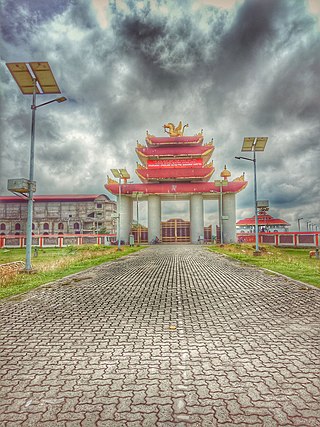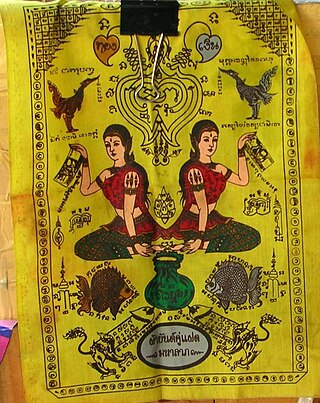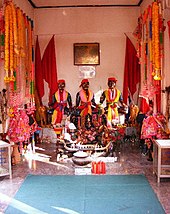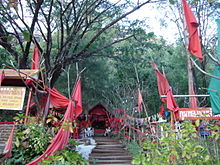
The veneration of the dead, including one's ancestors, is based on love and respect for the deceased. In some cultures, it is related to beliefs that the dead have a continued existence, and may possess the ability to influence the fortune of the living. Some groups venerate their direct, familial ancestors. Certain religious groups, in particular the Eastern Orthodox Churches, Catholic Church and Anglican Church venerate saints as intercessors with God; the latter also believes in prayer for departed souls in Purgatory. Other religious groups, however, consider veneration of the dead to be idolatry and a sin.

The Lao people are a Tai ethnic group native to Southeast Asia, who speak the Lao language of the Kra–Dai languages. They are the majority ethnic group of Laos, making up 53.2% of the total population. The majority of Lao people adhere to Theravada Buddhism. They are closely related to other Tai people, especially with the Isan people, who are also speakers of Lao language, native to neighboring Thailand.

The Ahom or Tai-Ahom is an ethnic group from the Indian states of Assam and Arunachal Pradesh. The members of this group are admixed descendants of the Tai people who reached the Brahmaputra valley of Assam in 1228 and the local indigenous people who joined them over the course of history. Sukaphaa, the leader of the Tai group and his 9,000 followers established the Ahom kingdom, which controlled much of the Brahmaputra Valley in modern Assam until 1826.

A spirit house is a shrine to the protective spirit of a place that is found in the Southeast Asian countries of Burma, Cambodia, Laos, Thailand, Malaysia, Indonesia, Vietnam and the Philippines. They are normally in the form of small roofed structure mounted on a pillar or a dais, and can range in size from small platforms to houses large enough for people to enter. Spirit houses are intended to provide a shelter for spirits that could cause problems for the people if not appeased. They often include images or carved statues of people and animals. Votive offerings are left at them to propitiate the spirits; more elaborate installations include an altar for this purpose.

Laos developed its culture and customs as the inland crossroads of trade and migration in Southeast Asia over millennia. As of 2012 Laos has a population of roughly 6.4 million spread over 236,800 km2, yielding one of the lowest population densities in Asia. Yet the country of Laos has an official count of over forty-seven ethnicities divided into 149 sub-groups and 80 different languages. The Lao Loum have throughout the country's history comprised the ethnic and linguistic majority. In Southeast Asia, traditional Lao culture is considered one of the Indic cultures.

The Tai Dam are an ethnic minority predominantly from China, northwest Vietnam, Laos, Thailand. They are part of the Tai peoples and ethnically similar to the Thai from Thailand, the Lao from Laos and the Shan from Shan State, Myanmar. Tai Dam means "Black Tai". This name comes from the black clothing worn by the group, especially females. In Vietnam they are called Thái Đen and are included in the group of the Thái people, together with the Thái Đỏ, Thái Trắng, Phu Thai, Tày Thanh and Thái Hàng Tổng. The group of the Thái people is the third largest of the 54 ethnic groups recognized by the Vietnamese government. The Tai Dam's language is similar to Lao, but Tai Dam use their own unique writing system and traditionally rejected Buddhism. According to the Tai Dam's creation story, the Lo Cam family is to be the ruling class and the Luong the priests.
The Saek or Tai Saek are an ethnic group of Laos and Thailand. The Saek are a part of the larger Tai ethnicity.

White Tai is an ethnic group of Laos, Vietnam and China. In Vietnam they are called Tai Dón or Thái Trắng and are included in the group of the Thái people, together with the Thái Đen, Thái Đỏ, Phu Thai, Tày Thanh and Thái Hàng Tổng. The group of the Thái people is the third largest of the fifty-four ethnic groups recognized by the Vietnamese government. They emigrated to Vietnam and Laos from Yunnan (China)

The Red Tai are an ethnic group of Vietnam and Laos. They speak the Tai Daeng language. In Vietnam, they are called Thái Đỏ and are included in the group of the Thái people, together with the Thái Đen, Thái Trắng, Phu Thai, Tày Thanh and Thái Hàng Tổng. The group of the Thái people is the third largest of the fifty-four ethnic groups recognized by the Vietnamese government.

Theravada Buddhism is the largest and dominant religion in Laos. Theravada Buddhism is central to Lao cultural identity. The national symbol of Laos is the That Luang stupa, a stupa with a pyramidal base capped by the representation of a closed lotus blossom which was built to protect relics of the Buddha. It is practiced by 66% of the population. Almost all ethnic or "lowland" Lao are followers of Theravada Buddhism; however, they constitute only 40-50% of the population. The remainder of the population belongs to at least 48 distinct ethnic minority groups. Most of these ethnic groups are practitioners of Tai folk religions, with beliefs that vary greatly among groups.

Me-Dam-Me-Phi is the most important veneration of the dead communal festival in the Ahom religion celebrated by the Ahom people on 31 January every year in memory of the departed. It is the manifestation of the concept of ancestor worship that the Ahoms share with other peoples originating from the Tai stock. It is a festival to show respect to the departed ancestors and remember their contribution to society.

Phi Fa is a deity or spirit in the local folklore of Thailand and Laos. It is also known as Phi Thaen. They play a prominent role in the Phra Lak Phra Lam and the stories of Khun Borom.

Baci/Basi and su kwan is an important ceremony practised in Lao culture, Sipsong Panna and Northern and Lao Isan.

Thai folklore is a diverse set of mythology and traditional beliefs held by the Thai people. Most Thai folklore has a regional background for it originated in rural Thailand. With the passing of time, and through the influence of the media, large parts of Thai folklore have become interwoven with the wider popular Thai culture.

Belief in ghosts in Thai culture is both popular and enduring. In the history of Thailand, Buddhist popular beliefs intermingled with legends of spirits or ghosts of local folklore. These myths have survived and evolved, having been adapted to the modern media, such as Thai films, Thai television soap operas, and Thai comics.

Mo or Moism is the religion of most Zhuang people, the largest ethnic minority of China. It has a large presence in Guangxi. While it has a supreme god, the creator Bu Luotuo (布洛陀), numerous other deities are venerated as well. It has a three-element-theory. Mo is animistic, teaching that spirits are present in everything.
Yao folk religion is the ethnic religion of the Yao people, a non-Sinitic ethnic group who reside in the Guangxi, Hunan and surrounding provinces of China. Their religion has been profoundly intermingled with Taoism since the 13th century, so much that it is frequently defined as Yao Taoism. In the 1980s it was found that the Yao clearly identified with the Chinese-language Taoist theological literature, seen as a prestigious statute of culture.

Kev Dab Kev Qhuas is the common ethnic religion of the Miao people, best translated as the "practice of spirituality". The religion is also called Hmongism by a Hmong American church established in 2012 to organize it among Hmong people in the United States.

Chinese folk religion plays a dynamic role in the lives of the overseas Chinese who have settled in the countries of this geographic region, particularly Burmese Chinese, Singaporean Chinese, Malaysian Chinese, Thai Chinese and Hoa. The Indonesian Chinese, by contrast, were forced to adopt en masse either Buddhism or Christianity in the 1950s and 1960s, abandoning traditional worship, due to Indonesia's religious policies which at the time forbade Chinese traditional religion or did not recognize it as a "religion," thus making it vulnerable to discrimination. Some Chinese Filipinos also still practice some Chinese traditional religions, besides Christianity of either Roman Catholicism or Protestantism, with which some have also varyingly syncretized traditional Chinese religious practices. Chinese folk religion, the ethnic religion of Han Chinese, "Shenism" was especially coined referring to its Southeast Asian expression; another Southeast Asian name for the religion is the Sanskrit expression Satya Dharma.

The Ahom religion is the ethnic religion of the Ahom people. The Ahom people came into Assam in 1228, led by a Tai prince Sukaphaa, and admixed with the local people. The people who came into Assam included two clans of priests, joined later by a third, who brought with them their own religion, rituals, practices and scriptures. The religion is based on ritual-oriented ancestor worship that required animal sacrifice (Ban-Phi), though there was at least one Buddhism influenced ritual in which sacrifice was forbidden (Phuralung). Ancestor worship and the animistic concept of khwan are two elements it shares with other Tai folk religions. There is no idolatry except for the titular god of the Ahom king and though there is a concept of heaven or a heavenly kingdom, there is no concept of hell. It was the state religion of the Ahom kingdom in the initial period.





















